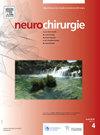机器人辅助MIS经髂骶髂关节融合术:技术说明。
IF 1.4
4区 医学
Q4 CLINICAL NEUROLOGY
引用次数: 0
摘要
背景:骶髂关节功能障碍(SIJD)占慢性腰痛的15-25%,常伴随腰椎融合。当保守治疗失败时,需要微创SIJ融合(SIJF)。机器人辅助技术可行且安全,可提高精度并减少辐射暴露。病例描述:一名26岁女性,L4-S1融合8年后,出现双侧SIJD,物理治疗和关节内类固醇注射难以治愈。表示SIJF。本文介绍了机器人辅助技术及其优点。结论:机器人辅助SIJF是一种安全、准确的治疗SIJD的技术,同时减少了辐射暴露。轨迹平面化和解剖变化的考虑使机器人辅助技术优于常规技术,如透视或导航。本文章由计算机程序翻译,如有差异,请以英文原文为准。
Robot-assisted MIS transiliac sacroiliac joint fusion: Technical note
Background
Sacroiliac joint dysfunction (SIJD) accounts for 15–25% of chronic low back pain and often follows lumbar fusion. When conservative therapies fail, minimally invasive (MIS) SIJ fusion (SIJF) is indicated. The robot-assisted technique is feasible and safe, enhancing accuracy and reducing radiation exposure.
Case description
A 26-year-old woman, eight years after L4-S1 fusion, presented with bilateral SIJD refractory to physiotherapy and intraarticular steroids injection. SIJF was indicated. Here we describe the robot-assisted technique and its advantages.
Conclusion
Robot-assisted SIJF is a safe and accurate technique to treat SIJD while reducing radiation exposure. Trajectories planification and consideration of anatomical variations give the robot-assisted technique an advantage over conventional techniques such as fluoroscopy or navigation.
求助全文
通过发布文献求助,成功后即可免费获取论文全文。
去求助
来源期刊

Neurochirurgie
医学-临床神经学
CiteScore
2.70
自引率
6.20%
发文量
100
审稿时长
29 days
期刊介绍:
Neurochirurgie publishes articles on treatment, teaching and research, neurosurgery training and the professional aspects of our discipline, and also the history and progress of neurosurgery. It focuses on pathologies of the head, spine and central and peripheral nervous systems and their vascularization. All aspects of the specialty are dealt with: trauma, tumor, degenerative disease, infection, vascular pathology, and radiosurgery, and pediatrics. Transversal studies are also welcome: neuroanatomy, neurophysiology, neurology, neuropediatrics, psychiatry, neuropsychology, physical medicine and neurologic rehabilitation, neuro-anesthesia, neurologic intensive care, neuroradiology, functional exploration, neuropathology, neuro-ophthalmology, otoneurology, maxillofacial surgery, neuro-endocrinology and spine surgery. Technical and methodological aspects are also taken onboard: diagnostic and therapeutic techniques, methods for assessing results, epidemiology, surgical, interventional and radiological techniques, simulations and pathophysiological hypotheses, and educational tools. The editorial board may refuse submissions that fail to meet the journal''s aims and scope; such studies will not be peer-reviewed, and the editor in chief will promptly inform the corresponding author, so as not to delay submission to a more suitable journal.
With a view to attracting an international audience of both readers and writers, Neurochirurgie especially welcomes articles in English, and gives priority to original studies. Other kinds of article - reviews, case reports, technical notes and meta-analyses - are equally published.
Every year, a special edition is dedicated to the topic selected by the French Society of Neurosurgery for its annual report.
 求助内容:
求助内容: 应助结果提醒方式:
应助结果提醒方式:


